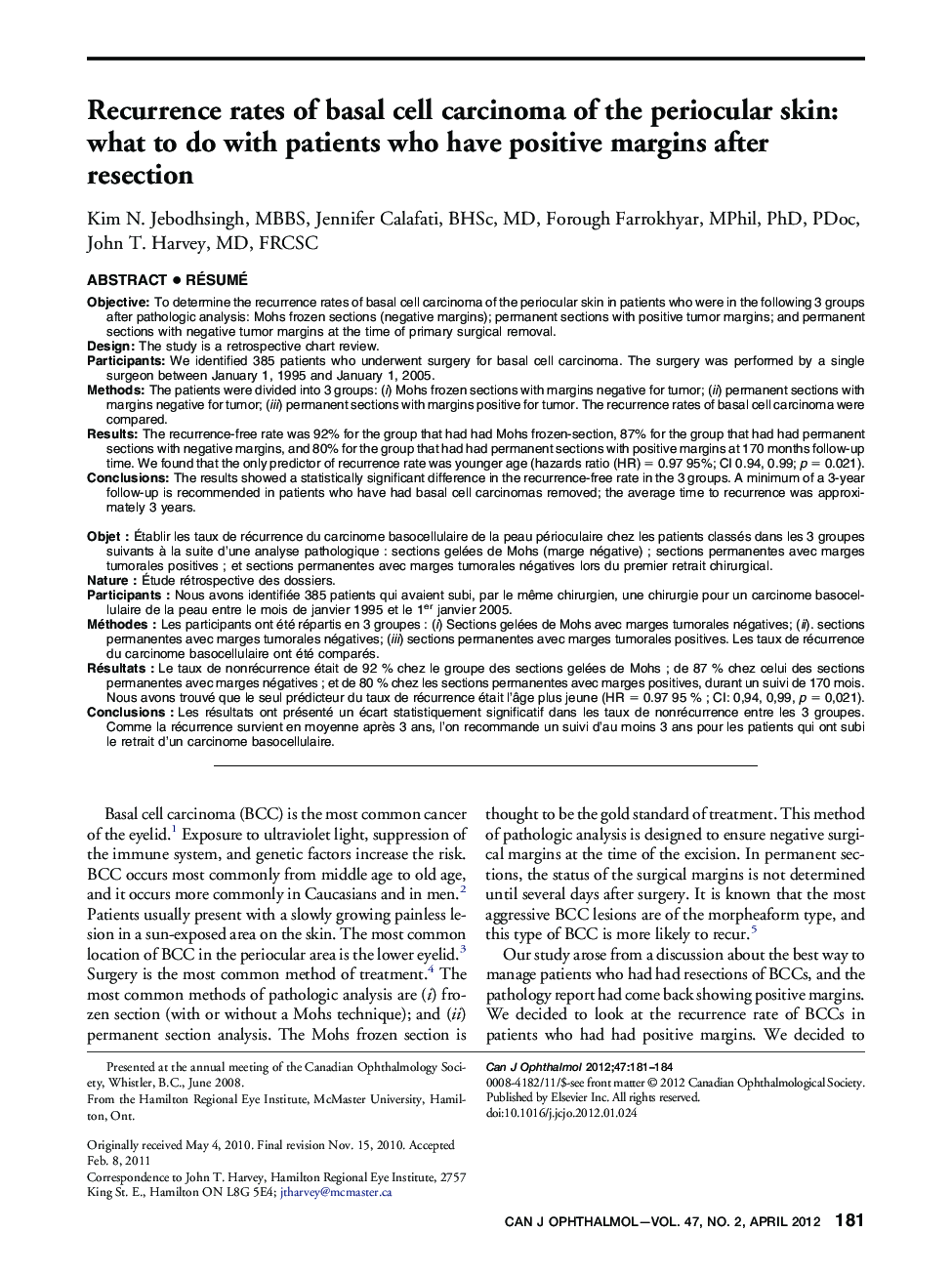| کد مقاله | کد نشریه | سال انتشار | مقاله انگلیسی | نسخه تمام متن |
|---|---|---|---|---|
| 4009510 | 1602416 | 2012 | 4 صفحه PDF | دانلود رایگان |

ObjectiveTo determine the recurrence rates of basal cell carcinoma of the periocular skin in patients who were in the following 3 groups after pathologic analysis: Mohs frozen sections (negative margins); permanent sections with positive tumor margins; and permanent sections with negative tumor margins at the time of primary surgical removal.DesignThe study is a retrospective chart review.ParticipantsWe identified 385 patients who underwent surgery for basal cell carcinoma. The surgery was performed by a single surgeon between January 1, 1995 and January 1, 2005.MethodsThe patients were divided into 3 groups: (i) Mohs frozen sections with margins negative for tumor; (ii) permanent sections with margins negative for tumor; (iii) permanent sections with margins positive for tumor. The recurrence rates of basal cell carcinoma were compared.ResultsThe recurrence-free rate was 92% for the group that had had Mohs frozen-section, 87% for the group that had had permanent sections with negative margins, and 80% for the group that had had permanent sections with positive margins at 170 months follow-up time. We found that the only predictor of recurrence rate was younger age (hazards ratio (HR) = 0.97 95%; CI 0.94, 0.99; p = 0.021).ConclusionsThe results showed a statistically significant difference in the recurrence-free rate in the 3 groups. A minimum of a 3-year follow-up is recommended in patients who have had basal cell carcinomas removed; the average time to recurrence was approximately 3 years.
RésuméObjetÉtablir les taux de récurrence du carcinome basocellulaire de la peau périoculaire chez les patients classés dans les 3 groupes suivants à la suite d'une analyse pathologique : sections gelées de Mohs (marge négative) ; sections permanentes avec marges tumorales positives ; et sections permanentes avec marges tumorales négatives lors du premier retrait chirurgical.NatureÉtude rétrospective des dossiers.ParticipantsNous avons identifiée 385 patients qui avaient subi, par le même chirurgien, une chirurgie pour un carcinome basocellulaire de la peau entre le mois de janvier 1995 et le 1er janvier 2005.MéthodesLes participants ont été répartis en 3 groupes : (i) Sections gelées de Mohs avec marges tumorales négatives; (ii). sections permanentes avec marges tumorales négatives; (iii) sections permanentes avec marges tumorales positives. Les taux de récurrence du carcinome basocellulaire ont été comparés.RésultatsLe taux de nonrécurrence était de 92 % chez le groupe des sections gelées de Mohs ; de 87 % chez celui des sections permanentes avec marges négatives ; et de 80 % chez les sections permanentes avec marges positives, durant un suivi de 170 mois. Nous avons trouvé que le seul prédicteur du taux de récurrence était l'âge plus jeune (HR = 0.97 95 % ; CI: 0,94, 0,99, p = 0,021).ConclusionsLes résultats ont présenté un écart statistiquement significatif dans les taux de nonrécurrence entre les 3 groupes. Comme la récurrence survient en moyenne après 3 ans, l'on recommande un suivi d'au moins 3 ans pour les patients qui ont subi le retrait d'un carcinome basocellulaire.
Journal: Canadian Journal of Ophthalmology / Journal Canadien d'Ophtalmologie - Volume 47, Issue 2, April 2012, Pages 181–184